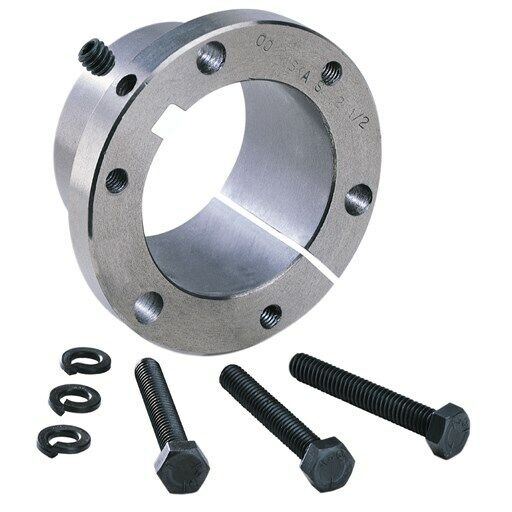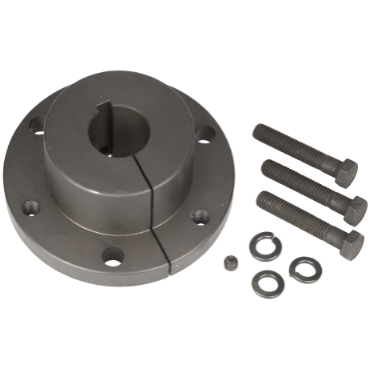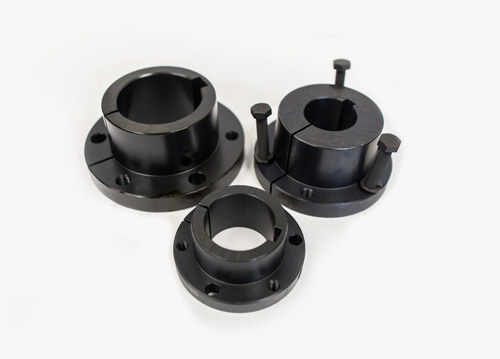Product Description
CHINAMFG Taper Lock Bush
The Taper Lock bush is a locking mechanism commonly used in Power Transmission Drives for locating pulleys, sprockets, and couplings to shafts. The Taper Lock bush is pre-bored and keyed to match the required shaft and keyway diameters. The outside of the bush is tapered to match the component bore that is to be located on the shaft.
CHINAMFG Taper bushes is manufactured from precision cast iron or carbon steel C45 with high quality finish. They are widely used to fit into Sheaves, Sprockets, Pins, V-belt Pulleys and Timing Pulleys.
Features :
· No need for re machining.
· No corrosion between bore and shaft.
· Easy-On/Easy-Off
· Material in Steel and cast iron are available
Types of Taper Bushings are available:
· ANSI Split Taper Bushings
· ANSI Taper Bore Bushings
· ANSI QD Bushings
1008, 1108, 1210, 1215, 1310, 1610, 1615, 2012, 2517, 2525, 3571, 3030, 3535, 4040, 4545, 5050
/* January 22, 2571 19:08:37 */!function(){function s(e,r){var a,o={};try{e&&e.split(“,”).forEach(function(e,t){e&&(a=e.match(/(.*?):(.*)$/))&&1
| Pulley Sizes: | Timing |
|---|---|
| Manufacturing Process: | Saw |
| Material: | Aluminum |
| Surface Treatment: | Hard Anodizing |
| Application: | Chemical Industry, Grain Transport, Mining Transport, Power Plant, Industry |
| Ht250 Gg25: | Phosphating |
| Customization: |
Available
| Customized Request |
|---|
Where can I find cost-effective QD bushings for agricultural equipment and machinery?
If you’re looking for cost-effective QD (Quick Disconnect) bushings specifically for agricultural equipment and machinery, there are several places where you can find them. Here are some options to consider:
- Agricultural Equipment Dealers and Suppliers: Contact local agricultural equipment dealers or suppliers who specialize in providing parts and components for farm machinery. These dealers often carry a range of power transmission components, including QD bushings. They may have cost-effective options suitable for agricultural applications. Visiting their physical stores or checking their online platforms can help you explore available options and compare prices.
- Online Marketplaces: Online marketplaces such as Amazon, eBay, and Alibaba can be valuable resources for finding cost-effective QD bushings for agricultural equipment. These platforms bring together various sellers, including distributors and manufacturers, offering a wide selection of industrial components. You can browse through the listings, compare prices, and read customer reviews to make informed purchasing decisions.
- Industrial Surplus Outlets: Industrial surplus outlets specialize in selling new, used, or discontinued industrial components at discounted prices. These outlets may have QD bushings available at lower costs compared to regular retail channels. You can search for local industrial surplus stores or explore online surplus marketplaces to find cost-effective options for agricultural machinery.
- Online Directories and Supplier Databases: Online directories and supplier databases specific to the agricultural industry can help you identify suppliers and manufacturers of power transmission components, including QD bushings. These platforms often provide information on multiple suppliers, allowing you to compare prices and request quotes directly from the suppliers. Examples of such directories include AgriExpo, Farm Equipment Guide, and Farm Industry News Supplier Directory.
- Manufacturer Websites: Many QD bushing manufacturers have their own websites where you can explore their product offerings, including those suitable for agricultural equipment. By visiting their websites, you can obtain information on available options, specifications, and pricing. Some manufacturers may offer cost-effective alternatives or have promotions specifically targeting the agricultural sector.
When searching for cost-effective QD bushings, it’s important to consider factors beyond just the price. Evaluate the quality, reliability, and compatibility of the bushings with your agricultural equipment. Assess the manufacturer’s reputation, warranty policies, and customer support to ensure a satisfactory buying experience and long-term performance of the bushings.
By exploring these sources and considering your specific requirements, you can find cost-effective QD bushings suitable for agricultural equipment and machinery, contributing to efficient and reliable operation while minimizing costs.
Can I get advice on selecting the right QD bushings based on torque, speed, and load requirements?
When selecting the right QD (Quick Disconnect) bushings based on torque, speed, and load requirements, it is crucial to consider several factors to ensure optimal performance and compatibility. Here is some advice to guide you in the selection process:
- Torque Capacity: Determine the maximum torque that will be transmitted through the QD bushing in your application. This can be influenced by factors such as the power source, driven component, and operating conditions. Check the manufacturer’s specifications for the QD bushing’s torque capacity rating. It is important to choose a QD bushing that can handle the anticipated torque without exceeding its limits to ensure reliable and safe operation.
- Speed Limitations: Consider the rotational speed or RPM (revolutions per minute) at which the QD bushing will operate. Higher speeds can generate centrifugal forces, which can affect the performance and stability of the bushing. Verify the manufacturer’s specifications for the maximum recommended speed rating of the QD bushing. Ensure that the selected bushing can handle the anticipated speed without compromising its integrity or causing excessive wear.
- Load Requirements: Evaluate the applied load on the QD bushing, including axial, radial, and moment loads. Consider factors such as the weight of the driven component, dynamic forces, and any external forces acting on the system. Check the manufacturer’s specifications for the load capacity ratings of the QD bushing. It is essential to select a bushing that can withstand the anticipated loads without experiencing excessive deformation or failure.
- Material Selection: QD bushings are available in various materials, such as steel, stainless steel, and cast iron. Consider the environmental conditions, temperature range, and potential exposure to corrosive substances or contaminants in your application. Choose a QD bushing material that offers the necessary strength, corrosion resistance, and durability for the specific operating conditions.
- Consult with Manufacturers and Engineers: If you have specific and complex requirements or are unsure about the selection process, it is advisable to consult with QD bushing manufacturers or experienced engineers. They can provide expert guidance based on their knowledge and experience. Sharing comprehensive information about your application, including torque, speed, load requirements, and other relevant factors, will help them recommend the most suitable QD bushing for your needs.
It is crucial to note that selecting the right QD bushings goes beyond torque, speed, and load requirements. Other factors, such as shaft diameter, shaft fit, axial positioning requirements, and compatibility with the driven component, also play a significant role. Always refer to the manufacturer’s specifications, guidelines, and recommendations to ensure proper selection and installation of the QD bushings in your power transmission or conveying system.
By considering these factors and seeking professional advice when needed, you can make informed decisions and choose the right QD bushings that meet your torque, speed, and load requirements, leading to optimal performance and longevity of your system.
Can I get step-by-step instructions on installing QD bushings for different mechanical setups?
While I can provide a general overview of the installation process for QD bushings, it’s important to note that the specific installation steps can vary depending on the mechanical setup and the manufacturer’s guidelines. It is recommended to consult the manufacturer’s instructions and specifications for the specific QD bushing you are using. However, here is a general outline of the steps involved in installing QD bushings:
- Gather the necessary tools and equipment: Before you begin the installation process, ensure you have the required tools and equipment on hand. This may include wrenches, torque wrenches, a mallet or hammer, and any additional components or accessories specified by the manufacturer.
- Prepare the shaft and the mounting component: Clean the shaft and the inner bore of the mounting component to remove any dirt, debris, or old lubricants. Ensure that the shaft surface is smooth and free from any damage or burrs that could interfere with the installation process.
- Inspect the QD bushing: Before installing the QD bushing, inspect it for any visible damage or defects. Ensure that the tapered surfaces and the flange are clean and free from any debris that could affect the installation or the connection with the shaft and the mounting component.
- Position the QD bushing: Place the QD bushing over the shaft, ensuring that it aligns properly with the desired location on the shaft. The flange of the bushing should be facing the mounting component.
- Engage the QD bushing: Apply even pressure to the outer surface of the QD bushing to initiate the engagement. This can be done using a mallet or hammer. Ensure that the bushing is centered and properly seated on the shaft. Avoid applying excessive force that could damage the bushing or the shaft.
- Tighten the QD bushing: Using the specified torque value provided by the manufacturer, tighten the QD bushing by turning the tightening screws or bolts evenly. Follow the recommended tightening sequence provided by the manufacturer to ensure an even and secure connection. Be careful not to over-tighten the bushing, as this can cause damage.
- Verify the installation: After tightening the QD bushing, inspect the connection to ensure that it is secure and properly aligned. Check for any axial movement or play between the bushing, shaft, and mounting component. Verify that the mounted component is positioned correctly and securely fastened to the bushing.
- Complete the installation: Once you have verified the installation, proceed with any additional steps required for your specific mechanical setup. This may involve attaching other components, aligning belts or chains, or performing any necessary adjustments or calibrations.
It’s important to note that the above steps are a general guide and may not cover all possible scenarios or variations. Always refer to the manufacturer’s instructions and guidelines specific to the QD bushing you are using. Following the manufacturer’s recommendations will ensure proper installation and optimal performance of the QD bushing in your mechanical setup.
editor by CX 2024-04-12




